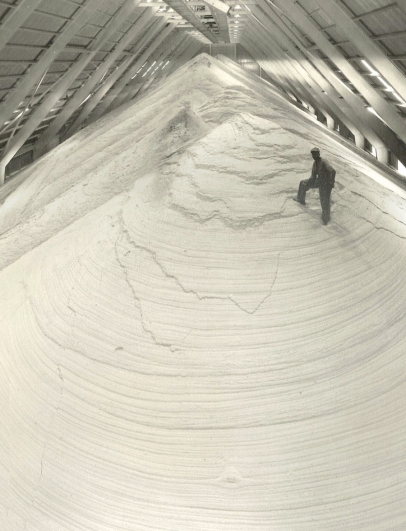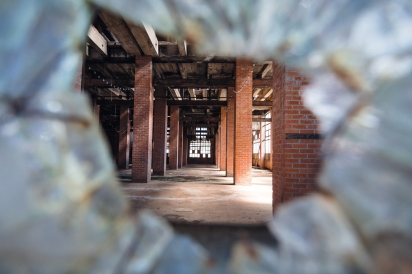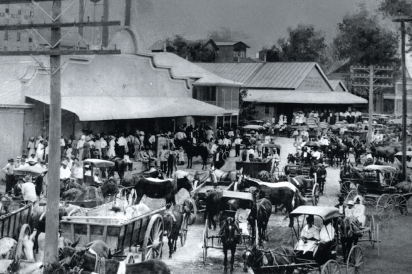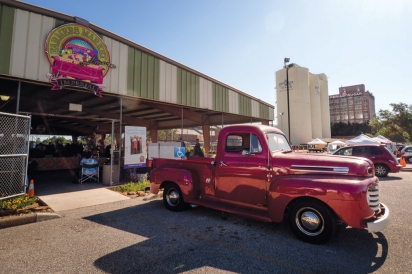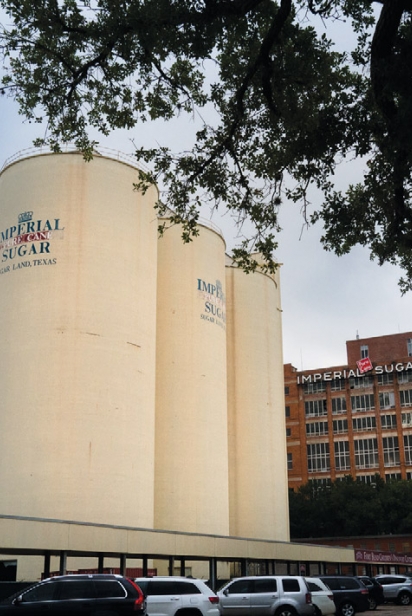From Sugar to City
Imperial Sugar remains a strong presence in former company town
On a recent trip to an antique store in Katy, I purchased an old sugar sack, torn along the edges by its previous owner to make it into a tea towel. It was the faded Imperial Sugar logo that caught my eye, bringing back memories from my third-grade visit to the refinery: jars of gooey molasses-like substances representing stages of the refining process, the gleam of the machines, the unexpectedly pungent smell and kids making fun of each other as we donned the funny hairnets before the tour.
I was surprised at my nostalgia; after all, Imperial is just another big-company brand at the store. But there’s rich Texas history contained in that “Pure Cane” logo crowning the Imperial Sugar char house in downtown Sugar Land, connecting the city to its very deep roots.
Stephen F. Austin gifted the land that eventually became Sugar Land in 1828 to Samuel May Williams, who dubbed it Oakland Plantation and planted sugarcane imported from Cuba. Williams’ brothers built the first commercial mill on the property in 1843, processing sugarcane into raw sugar. Operations expanded and contracted under the visions of various owners until W.T. Eldridge and I.H. Kempner acquired the property in 1908.
They wanted to transform Sugar Land into a self-sufficient town to support the newly incorporated Imperial Sugar Company. Their plan soon provided workers with new homes, entertainment and amenities, including a weekend market along what is now Kempner Street. Eventually, Imperial shifted to importing sugarcane, but beginning with the first mill in 1843 to the Imperial refinery closure in 2003, sugar was continuously produced here.
For those 160 years, Sugar Land was obviously a land of sugar. Because of residents who are still attached to its “Pure Cane” history, it still is today.
“The uniqueness of this town is not that they were the only [company town],” explains Paula Jay, docent at the Sugar Land Heritage Foundation. Sugar Land is special, she says, because of how well the Imperial Sugar Company took care of employees and their families. Going back to 1908, Sugar Land has been “a place that does it right. That started with Kempner and Eldridge,” says Hal Jay, also a docent at the Heritage Foundation. “These guys wanted … to make Sugar Land the go-to place to spend your life and raise your families.”
Imperial did more than build amenities for residents. The company did not raise rent for workers as long as they remained employed by Imperial; it hired children of deceased employees to retain the family’s benefits; and even though the company had to cut back in the Depression, Kempner made sure “every family still had a revenue stream,” says Hal Jay.
In the mid-20th century, in order to avoid Houston’s rapid annexation of its surrounding neighborhoods, Imperial sold all the company homes to the existing residents so that they could have voting rights as property owners and in 1959, homeowners voted to incorporate and become the city of Sugar Land. It was no longer a company town, but its growth was guided by the philosophy of Kempner and Eldridge. “It wasn’t bottom line,” says Paula Jay. Imperial continued to play a role as THE company everyone wanted to work for.
“It truly was a family company,” says retired employee Marion Raska, who began his career in 1972, because “your dad worked there, your grandpa worked there.”
The philosophy lingers today, even though the city has exploded with growth. New residents may not move to Sugar Land knowing about its rich history, but once they make it downtown to the Sugar Land Heritage Foundation, they’re delighted to learn about it. “People soak it up!” says Hal Jay.
Today, locals can again visit a market along Kempner Street with the Imperial buildings providing a historic backdrop. And if they venture a few steps past the market, they can enjoy the monthly walk with Heritage Foundation docents through “The Hill,” a still-thriving neighborhood north of the refinery, to discover its history, including original Craftsman homes built by Imperial. Catherine Bilow led a walk for me, wearing her Heritage Foundation shirt emblazoned with an image of the char house and delighting me with stories of the people—past and present—who are part of Sugar Land’s story.
Bilow and I began the tour by peering through a broken window into the char house, appreciating the stripped industrial textures of the spacious ground-floor room. This is where workers used to add bone char to liquid sugar to purify it and render it “pure cane.” Empty now, this iconic building will soon come back to life as a boutique hotel fronting Imperial Market, a mixed-use lifestyle center developed by Geoffrey Jones and James Murnane.
Looking for a project with a “feeling of legacy,” Murnane says that it was the “beautiful old buildings” that drew them to Imperial. Existing structures will house shopping, entertainment and restaurants: Visitors can anticipate dining inside the silos, relaxing on a platform built around the old smokestacks and perusing historic photographs provided by the Heritage Foundation inside the hotel.
Part of a larger Imperial expansion managed by Johnson Development that will settle the area around Constellation Field with neighborhoods and apartments, the Imperial Market honors the old in the middle of all the new. With a commitment to do things right that recalls Kempner and Eldridge so many years ago Murnane and Jones’ plans include relocating the smokestacks rather than (more cheaply) re-creating them and planting heritage sugarcane along Oyster Creek. And, at the center of the development, the Heritage Foundation will open a new museum that, according to SLHF board member Marty Nicholas, will feature an interactive timeline to show how Sugar Land is “where Texas as we know it began.”
Sugar Land is a fast-growing, modern city now, but it all comes back to some sugarcane, a mill and men with a vision to create something special. It’s a story to be proud of, and it’s a story still being told in the land that sugar built.
FROM CHAR HOUSE TO MARKET
Underneath the watchful windows of the Imperial char house, Sugar Land residents gather Saturday mornings for the market along Kempner Street, resurrecting a tradition that goes back over 100 years.
Originally planned to open for only one season the Farmers Market at Imperial “was so fun and so successful,” says market manager Kim Broom, that it became a permanent, year-round fixture. She is especially proud of how welcoming this market is to start-up entrepreneurs: “One of the fun things about the market is how many vendors have been launched here … people who just had an idea.” Many of them remained with the market, even when they were growing bigger.
The Farmers Market at Imperial is relaxed, spacious and welcoming to entire families with kids’ activities like hula hoops and face painting, a food truck, live music, treats for the dogs (and their humans) and piles of beautiful produce. Broom appreciates the passion that residents have for Sugar Land’s history.
“Sugar Land residents love a place where they can walk around, grab breakfast and see friends.” Just like old times.
> The Farmers Market at Imperial (imperialfarmersmarket.com) is located at 198 Kempner St. Sugar Land on Saturdays 9am–1pm


